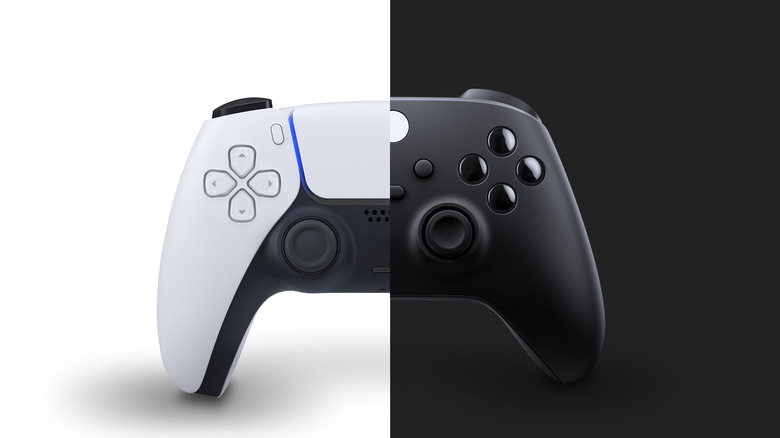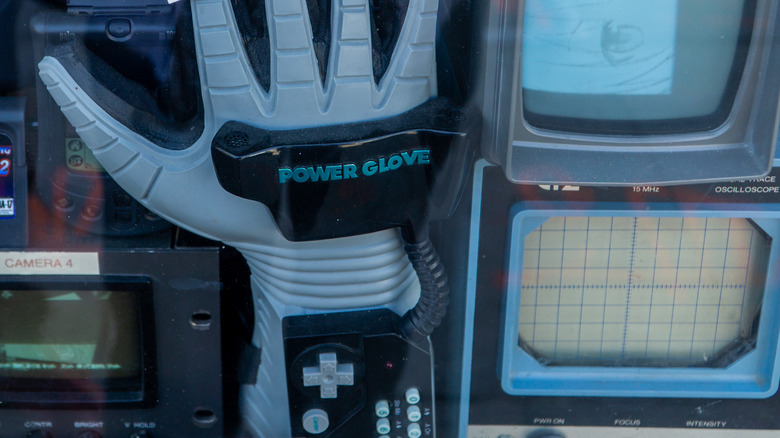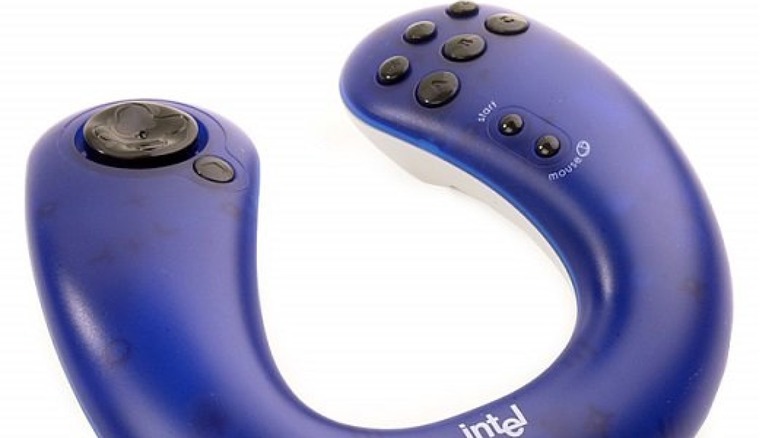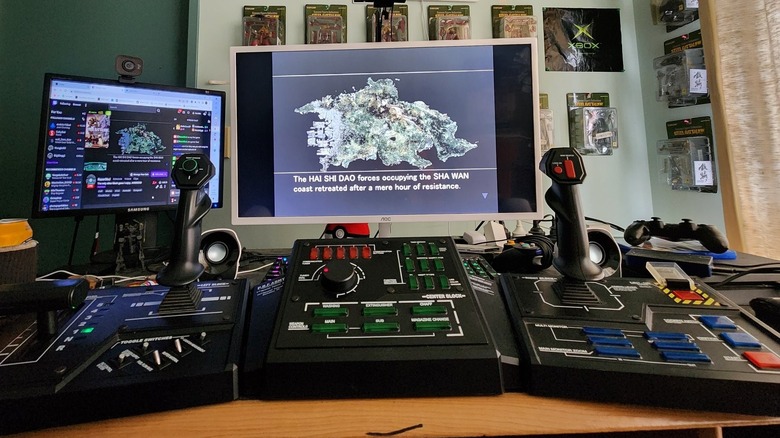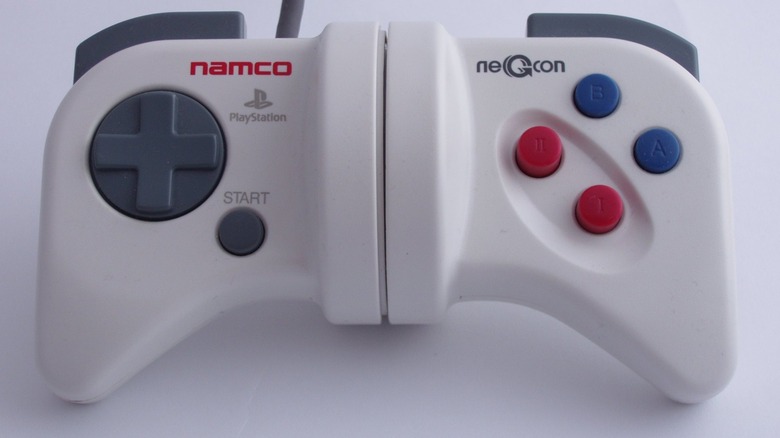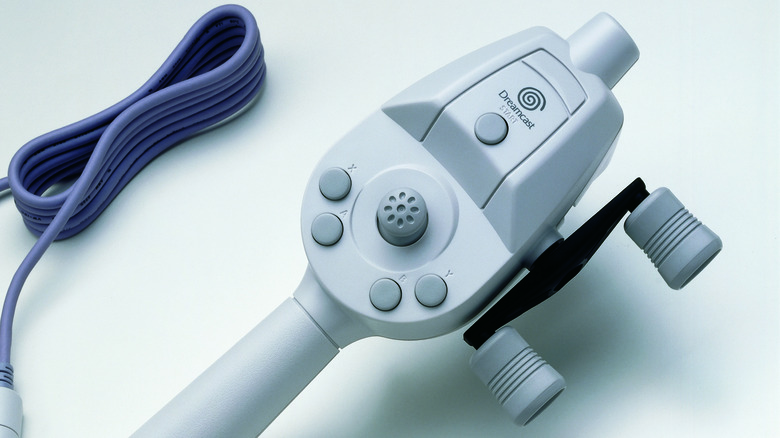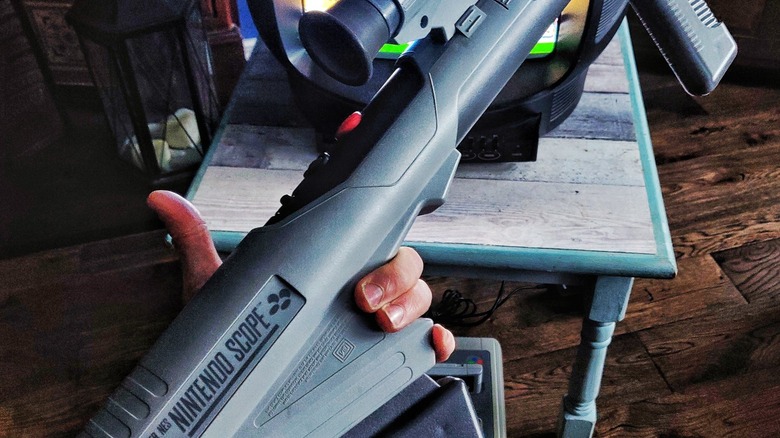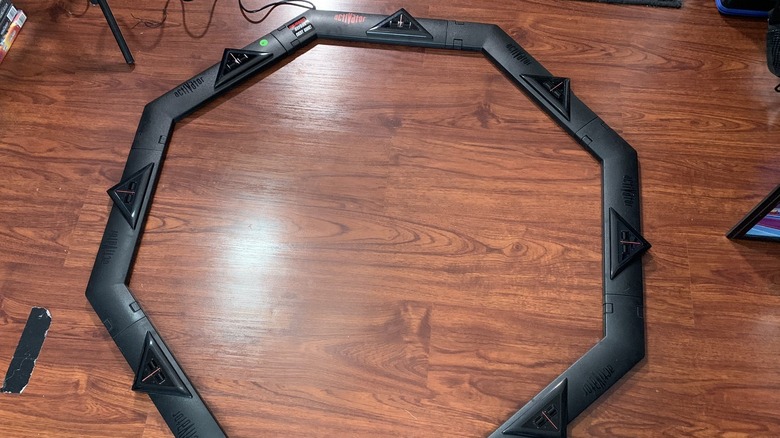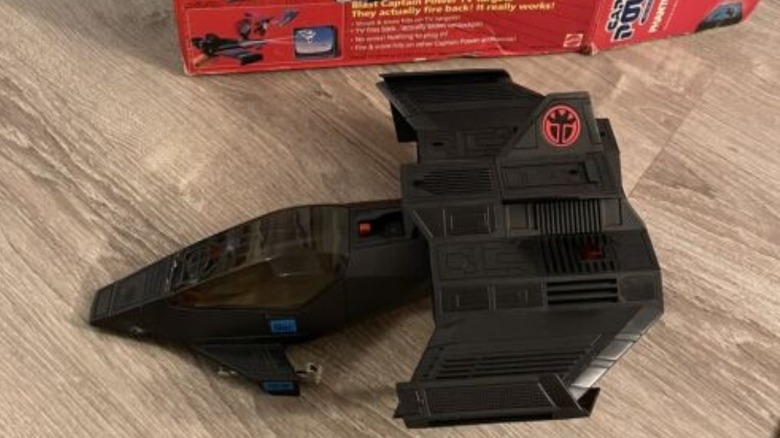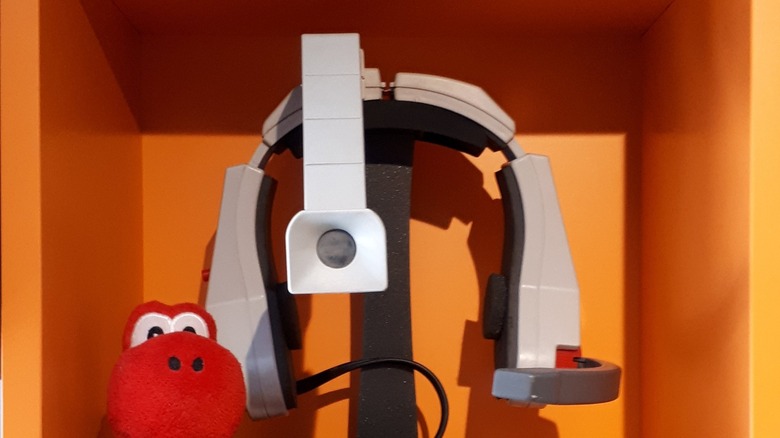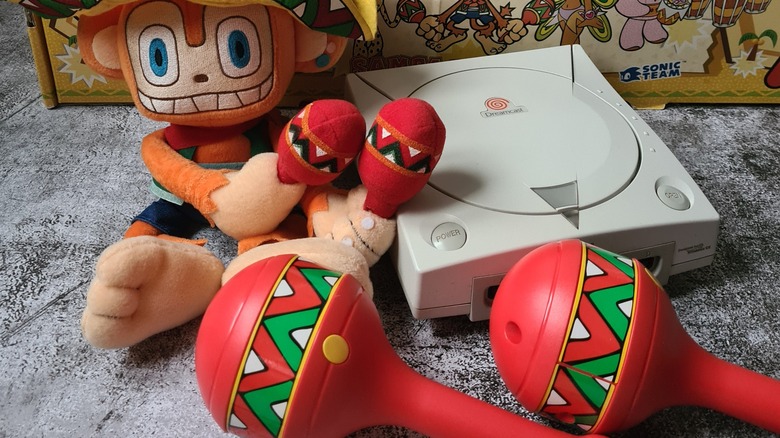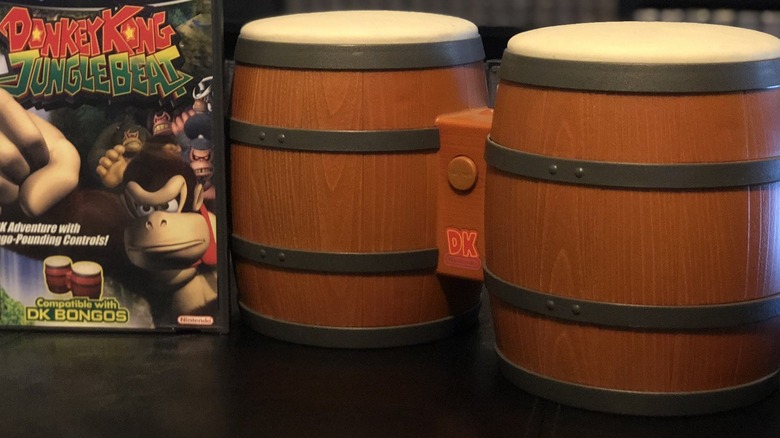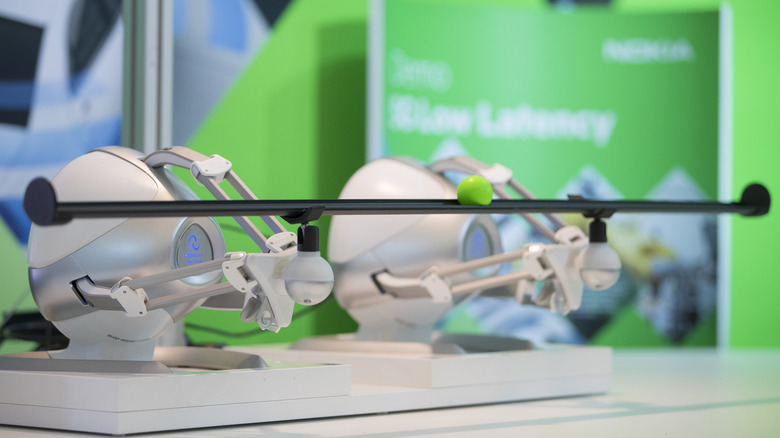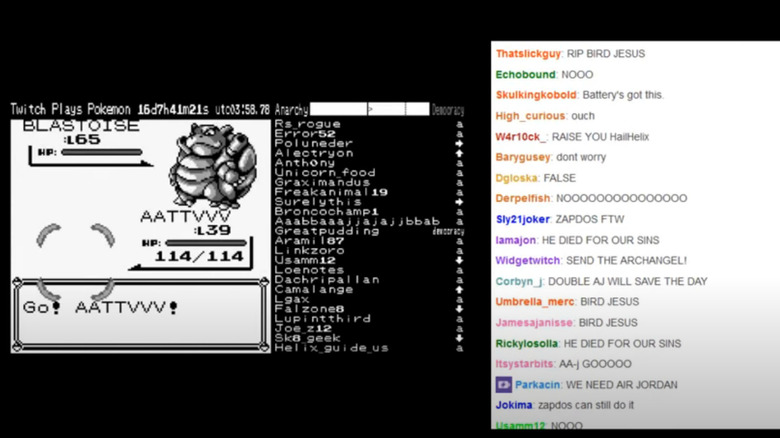The Most Bizarre Video Game Controllers Of All Time
Ever since the start of video gaming, controllers have been the top way to play. Sure, you can put a keyboard and mouse into modern consoles, but should you? The iterative process that created the best video game controllers – like the Xbox Series controller and the PS5's DualSense – has been decades in the making. Video game console manufacturers and their third-party counterparts have refined the modern controller shape so that there is little deviation from the recipe of two sticks, two triggers, two bumpers, and some face buttons.
It wasn't always like this, though. Video game companies were fearless in taking risks, as the market hadn't coalesced around a common control system. They made light guns that could detect where on the screen they were pointed when you pulled the trigger. Motion control schemes were thought up using held accessories or full-body sensing. Some of these efforts worked, and some were genuinely bizarre. It's those last ones we're chronicling here before they slip away into obscurity and mythos.
NES Power Glove
Nintendo might be known for its user-friendly controllers now, but in the early days of the Nintendo Entertainment System (NES), the company created all kinds of controllers to see what worked. One of those controllers was the Power Glove, a forearm-length gauntlet with motion controls and a bunch of buttons so you could use it as a wrist-mounted gamepad. Sounds pretty wild, but the crazy thing is that the version that hit the market was a toned-down version of what the company that created the Power Glove was trying to achieve.
The other thing is that Nintendo didn't create the Power Glove, Abrams Gentile Entertainment did, and they were trying to make a VR system in partnership with Hasbro (via Destructoid). They found a patent from the MIT design clinic around motion controls, and the Power Glove was born. The VR system never materialized, but the controller was repurposed to control 2D games. It was a flop as a game controller. Still, it was popularized in "The Wizard" and "Captain N: The Game Master" before Congress passed the Children's Television Act, limiting how children's entertainment could be used to sell toys.
Intel Wireless Series gamepad
Intel tried pushing into computer gaming peripherals in the late '90s and early '00s, and the Intel Wireless Series was one of their efforts. The system was centered around the Intel Wireless Series Base Station, which could connect eight devices to one wireless receiver (unheard of at the time). Intel created three wireless devices that worked with the Base Station, a boring Mouse and Keyboard (capitalization Intel's), and the weird, wacky, and wonderful Intel Wireless Series Gamepad. Up to four of these controllers could pair to the Base Station,
This U-shaped controller connected to the base station wirelessly with two button taps, which is something we now take for granted. It had a D-pad, six programmable action buttons, two triggers, and a shift button that made each button mappable to two actions. There was a button to hold down that turned it into a virtual mouse, and it even had software to program up to 28 macro sequences. It also looked weird, falling between a neck pillow, a flight yoke, or a personal massager.
Mega Jockey 9000
Most video game controllers are multipurpose so they can be utilized on any title on the console or computer they were made for. The Mega-Jockey 9000 was made for one game and one game only – "Steel Batallion" — which came out in 2002 for the original Xbox console. Instead of multipurpose buttons, the sprawling controller was an entire cockpit of controls for piloting vertical tanks, "all about creating a quality peripheral and appropriate software to go with it" (via SVG). The three feet wide control cockpit requires both hands, feet, and most of your brain cells and coordination to master.
You had two joysticks (one for each hand), three foot-pedals, two levers, and 40 buttons split between a left-side block for steering and a right-side block for aiming and combat. Physical controls for anything you needed to pilot your mech were in arms reach, from a complicated startup and shutdown procedure to an eject button protected by a flip-up transparent plastic shell to prevent accidental use. The central section of the controller handled communications, mission-specific tasks, and even windshield wipers. It's an insane amount of control surface for a mech simulator.
Brøderbund U-Force
Before Joy-Cons, Kinect, and PS Move was the U-Force motion-control peripheral created for the Nintendo Entertainment System near the end of the '80s. Two panels at 90 degrees to each other used infrared sensors to figure out where your two hands were, and the system could read movements and positions in the 3D space created between the sensors. Those movements could control in-game actions, like boxing in 1987's "Punch-Out" or other NES titles. Any NES title, to be exact, as Brøderbund said the controller could work with any game created for the console.
Or, it could control in-game actions, as the U-Force didn't work as often as it did. The future, hands-free control system that it promised was just that: a promise. To add insult to injury, the U-Force cost $70 when it came out in 1989. That's nearly $170 in 2022 adjusted for inflation, or almost the price of Nintendo's handheld console, the Game Boy, in 1989.
Namco NeGcon
We will always wonder why anyone decided twisting a controller's halves to turn was a good idea. Well, at least several people at Namco thought it would be a viable way to control video games, so the NeGcon was created. Compatible with the PlayStation and PlayStation 2, the NeGcon had analog buttons that were perfect for controlling acceleration and braking in racing titles. The party trick was that the two halves could twist up to 180 degrees and were usually configured to steer left or right.
Twist it left to go left, twist it right to go right, and don't worry about feeling like you are about to snap the controller. At least, you weren't supposed to feel that was possible, but it certainly was a consideration. You also had fewer buttons than a non-DualShock PlayStation controller. L2 was missing, as were R2 and Select. The game had to specifically support the NeGcon, with a few dozen games available, mostly on the PS1. There was no consistency across the games though, as you might use the full range of twists on some titles and others only supported a fraction of the range.
[No machine-readable author provided. Malcohol assumed (based on copyright claims),via Malcolm Tyrrell. | Cropped | CC BY-SA 3.0]
Sega Fishing Rod for Dreamcast
Do you know how every JRPG seems to have a fishing quest? There's an excellent reason — the Japanese are crazy about digital fishing experiences. "Final Fantasy XV" ended up with a spin-off game for PlayStation VR, "Monster of the Deep: Final Fantasy XV," because the lure of the deep is strong. Most in-game fishing uses the standard controllers, but it wasn't always like this. In 1997, Sega created a specialized fishing rod accessory to go with "Sega Bass Fishing" on the Dreamcast console.
The peripheral looks like a fishing rod, shortened, with only the handle and reel. It had motion sensors for casting and catching duties, haptics to vibrate when a fish is hooked, and an analog joystick, A, B, X, Y, and Start buttons. Sega made a handful of other fishing titles that used the controller. The publisher also made it compatible with "Virtua Tennis" and "Soulcalibur," showing that the trend of controlling video games with odd controllers isn't recent.
SNES Super Scope
Light guns were all the rage in the days of CRT televisions. They worked by taking advantage of how CRTs refresh the screen, one pixel at a time, from the top left to the bottom right. The NES Zapper from the Nintendo Entertainment System was great, but something weird happened when it came to the Super Nintendo Entertainment System's turn. Nintendo decided that the jump to a 16-bit console deserved a bigger light gun to match the jump in power.
The result was the Super NES Nintendo Scope 6, or Super Scope for short. As unwieldy as the full name was, it was nothing compared to how annoying the gun was to use. For a start, the bazooka-shaped zapper was almost two feet long. It also needed six AA batteries. Six! In an era when alkaline batteries were expensive, and rechargeables were even more so. The wireless nature did make it look cool but bugging your parents for more batteries got old fast. Only a few games supported the controller, making one of the coolest video game accessories of the '90s into a footnote of history.
Tony Hawk Ride Skateboard
Anyone who has ever played a "Tony Hawk's Pro Skater" skateboarding video game knows that the draw isn't being able to skate — it's about being able to pull off gnarly combos, aerials, and other moves while not being able to balance on an actual skateboard. That illusion was shattered like your femur after falling from the halfpipe with 2009's "Tony Hawk: Ride." This installment of the Tony Hawk series wasn't played with a hand-held controller. Instead, it needed a plastic skateboard stuffed with motion sensors and accelerometers to play.
The new requirement for actually being able to balance on a skateboard without wheels put off many gamers. So did the $120 price for the game and the potentially dangerous controller. You couldn't even buy the game and use a normal controller as it was developed to only work with the Ride skateboard. If you want to try the horror of using a plastic balance board to control a Tony Hawk game you can still pick them up on eBay for $20 or so.
Sega Activator
It's not just your parents that worried about the effects of sitting on the couch playing video games. The companies making the consoles and other hardware were also worried, at least if all the controllers designed to use when standing up are any indication of their thought processes. Sega wasn't immune to this and back in the 16-bit era, the Sega Activator was unleashed on those Sega Genesis owners that could afford it. The octagonal controller cost $80 and took up most of the floor in front of your TV. Oh, and you needed another plug socket as the infrared light beams it put out required lots of power.
The controller used your body as the input. Standing inside the octagon and moving body parts triggered the same buttons a handheld controller had. Sega's promotional materials had martial artists throwing shapes in the ring, insinuating that the Activator would turn players into martial arts masters. It did no such thing, and only "Eternal Champions," "Mortal Kombat," and "Comix Zone" fully supported the range of inputs the motion sensing controller could create. Ceilings that were higher than the pre-calibrated height threw the sensor's ability to read body movements, as did ceiling mirrors, beams, ceiling fans, or irregular surface finishes. Remember, this came out in 1993 when stucco popcorn-style ceilings were popular.
Captain Power and the Soldiers of the Future
Does a light gun triggered by a weekly sci-fi TV show aimed at kids count as a video game controller? "Captain Power and the Soldiers of the Future" was revolutionary when it aired in 1987. Written by J. Michael Straczynski, who would create "Babylon 5" a few years later, the TV show ran for 22 episodes. Encoded into the broadcast was a way to interact with light sensors on the accompanying toys. These included two spaceships with a pistol grip underneath, six action figures (three for each faction), and two accessories.
Some on-screen elements were picked out in orange or yellow lights during the broadcast. During the battle scenes that these bright lights showed, if you pointed the light gun containing toys at the screen and pressed the trigger, you could seemingly interact with the TV. The toy kept score, starting at five points and gaining points every time you 'shot' an orange patch. Yellow lights 'shot' your player if you didn't shoot back, and the toy would delete one point. When you reached zero points, the cockpit of the toy ejected your action figure across the room. There were even pre-recorded VHS tapes so you could go on missions of differing difficulty. The TV show was fully live-action and the VHS tapes were also live-action at the beginning and end of each task. The central section was well-produced anime and was animated as if you were playing an FPS game.
Konami LaserScope for NES
Another gimmicky light gun accessory was the Konami LaserScope which was created for the NES console. The head-mounted light gun was every sci-fi or anime-watching kid's fantasy controller. It didn't just have a targeting reticle that hung over your right eye like a cool fighter pilot from the future. Oh no, the LaserScope was voice-activated at a time when voice assistants or even smartphones were something from the imaginary worlds of books and TV shows.
Created for the 1991 game "Laser Invasion," the head-mounted light gun would have been great except for one thing — it didn't really work. To shoot you yelled "Fire!" into the boom microphone, or tried to because the LaserScope was notoriously easy to activate. Any background noise would make it fire, from your parents wandering around in the kitchen to dogs barking, the telephone ringing, or your hands as you tried to find where you put your NES Zapper so you could actually play a game.
Samba de Amigo maracas
Rhythm-based games often have special controllers that resemble the on-screen instruments that are being played. "Samba de Amigo" first began as an arcade classic when released in 1999, and you used two maracas to control the game. Think of a combination of a dancing game and a rhythm game like "Guitar Hero," but with maracas, and you're on the right track. Players controlled an onscreen dancing monkey wearing a sombrero by shaking their moneymaker, and it was a hit when Sega ported it to the Dreamcast console in 2000.
The gameplay consisted of a repetitive cycle of shaking the maracas in high and low positions and to the left and right of where you stood. The main game had career, training, and single-player modes which were almost the same gameplay. Sega spiced things up with a few minigames like breaking rocks or smashing a piñata, all to sultry Latin beats. The game was brought back in 2008 with the launch of the Wii console, with maraca shells that you clipped the Wiimote into. You needed two Wiimotes though, so buying a second controller was an expensive thing to play one game.
Donkey Kong Jungle Beat bongos
Nintendo is on this list many times for good reason — their roots as a traditional game manufacturer give them a different viewpoint on what works for the market than other video game hardware manufacturers. In 2004, it created a pair of bongos for "Donkey Konga," a rhythm-based game using the Donkey Kong franchise characters. You could drum on the left or right bongos or clap, thanks to the internal microphone, to bop along with the tracks.
The controller came back the next year for "Donkey Kong Jungle Beat," which was a traditional side-scroller but controlled by the DK Bongos. Slapping the left bongo moved you left, booping the right bongo moved you right, hitting both together made Donkey Kong jump and clapping was replicated in-game with a simian-powered shockwave. It was a strange feeling using a non-traditional controller for a traditional side-scrolling game but it felt good. It reduced the gaming formula to a rhythm game, and perhaps was the inspiration around gamers using non-standard controllers for games like "World of Warcraft."
Novint Falcon
Controllers for human control of computers take many forms. The Novint Falcon is one of the most bizarre designs ever to grace a desk surface. The dual arms of this controller look like the joysticks used to control robotic arms, and that's not far from the truth. Novint created them to manipulate digital objects in 3D space and to pass force feedback to the user. It used haptic vibrators and small motors to simulate movements like pulling back a rubber band or moving your weapon around in an FPS game.
Like the real object, pulling the Falcon's articulated arms further back gave increasing resistance to the user's arms. It could simulate touching ice, or sticky substances like molasses, or the roughness of sand. A later mod for "Crysis" made it so that weapon recoil could be passed to the player, or feel the acceleration or centrifugal force of whipping in-game vehicles around like a rally driver. Changing modes in the in-game Nano Suit adjusted the level of feedback, making gamers "feel stronger when lifting objects" and other enhancements to the normal level of feedback.
Twitch chat
Live streaming site Twitch turned into a game controller, thanks to a carefully coded chatbot. The bot read the live chat to pick up commands and brought those into the game being played. An interesting social experiment at the outset, Twitch Plays, turned into a phenomenon. The first game played using the chatbot was "Pokémon Red." Thousands of people at a time crowded into the chat to help, hinder, and troll the stream. Two factions emerged — one wanting to help the young Pokémon trainer, and one that wanted him to lose everything. Eventually, the game was successfully finished, with a supporting cast of millions of Twitch viewers (via ScreenRant).
After that success, Twitch Plays decided to set its gestalt to beating the notoriously difficult "Dark Souls." It was glorious chaos, with the player character struggling to leave the starting room. After 43 days (via whydoyoubark), the Herculean task was done. The game's final boss, Gwyn, had been felled by the hordes of chat participants. Twitch chat has also been called into action to control stock trades, with one streamer putting $50,000 of his own money on the line.
